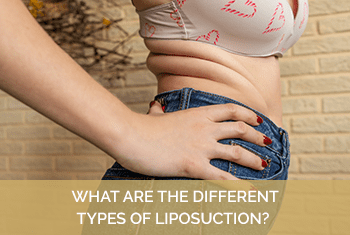There are several different types of liposuction and you should work with a certified plastic surgeon in order to decide the best type for your goals. Your surgeon will be able to help you understand the advantages and disadvantages of each variation, the treatment areas each is appropriate for, and how previous procedures could impact the results.
Understanding the basic differences among the types of liposuction is the first step towards a more sculpted body.
Types of liposuction
Tumescent Liposuction

Tumescent liposuction surgery is the most commonly performed variation. To perform this type of liposuction, your surgeon will inject a steriles solution into your treatment area. This solution is typically a mixture of saline to help with the removal of fat, an anesthetic to help relieve any pain caused, and a drug that causes the blood vessels in the area to constrict. The injection of this sterile solution will cause the treatment area to swell and stiffen slightly. Next, your surgeon will make some small incisions into your skin and insert a very small tube under your skin. The thin tube is called a cannula and is connected to a vacuum that suctions fat and fluids from the treatment area.
Ultrasound-assisted liposuction (UAL)
Ultrasound-assisted liposuction can be a stand alone procedure or be used in partnership with tumescent liposuction. During this procedure, your surgeon will make a small incision and then insert a metal rod under the skin. The metal rod will then emit ultrasonic energy that helps to rupture fat-cell walls and breaks down fat in the treatment area in order to aid removal. The broken down cells are then suctioned out.
Laser-assisted liposuction (LAL)

Laser-assisted liposuction surgery, as the name indicates, uses a high-intensity laser to break down fat cells to make them easier to remove. This is accomplished by inserting a small laser fiber under the skin through a small incision. The laser fiber then emulsifies fat cells in the treatment area and a cannula suctions out the liquefied fat.
Power-assisted liposuction (PAL)
Power-assisted liposuction is another very common procedure due to the precision it can provide. In this liposuction surgery, a cannula is powered and moves back and forth quickly under the skin. The vibration of the powered cannula makes the technique quicker and more efficient. This type of liposuction often causes less pain and swelling than others. PAL is also very effective for large volumes of fat that needs to be removed or if you have undergone previous procedures. This is often used in full-body liposuction procedures.
Differences in the types of liposuction
Some liposuction procedures may require localized anesthesia, which is specific to the treatment area. Others will necessitate general anesthesia that “puts you under”. Either of these may involve a sedative that calms and relaxes you for the procedure.
Just like any other medical procedure, the surgeon and the surgical team will keep a close eye on your vitals throughout the surgery. This includes IV fluid management, monitoring heart rate, blood pressure, and more.

The length of each procedure is more dependent on the treatment area and goals than on the type of liposuction used. A liposuction surgery may last several hours, with the addition of recovery time if you are placed under general anesthesia. If the fat removal is extensive, you may stay overnight in the surgery facility to monitor fluids and vitals.
After your liposuction surgery
Once your surgeon has decided what type of liposuction will help you reach your goals, they will be able to explain post-surgery care and what to expect. Depending on the type of liposuction used, you may have slight to severe bruising in the area treated and may be sore from the vibration or suction.
Under certain circumstances, your surgeon may leave incisions open and insert temporary drains to help facilitate healing. For most procedures, you will need to wear tighter, compression style clothing to help keep swelling down. Antibiotics are often prescribed post-surgery to reduce the risk of any infection.
Like all cosmetic procedures, it is important to understand your goals for the surgery, as well as the different treatment options available. Your surgeon will likely share before and after liposuction results to showcase outcomes you can expect.
Dr. Kitto is a Board-certified plastic surgeon performing liposuction surgery in Richmond, Virginia. She specializes in helping people feel better about their bodies through a variety of surgical, minimally invasive, and non-invasive procedures.
Schedule a liposuction consultation with Dr. Kitto today to find out how you can benefit from liposuction and enjoy a newly sculpted body.
Call us at 804-294-1777 Now you can also book weekend appointments with Dr. Kitto.

